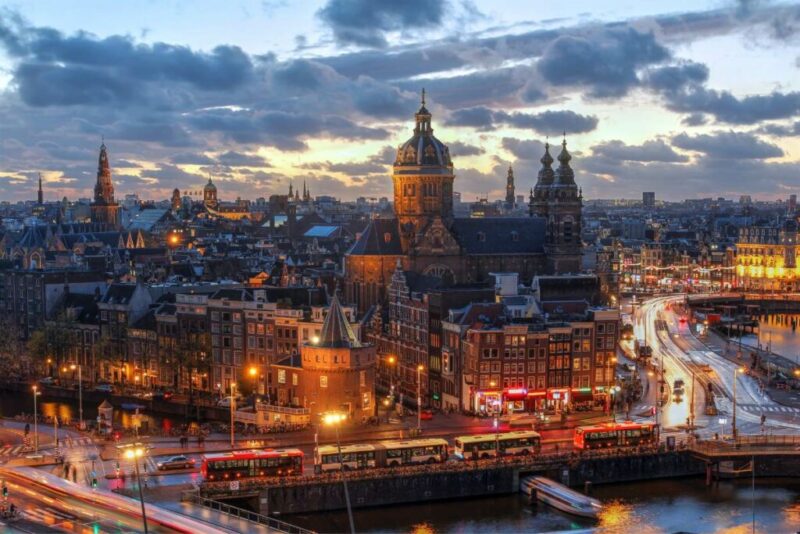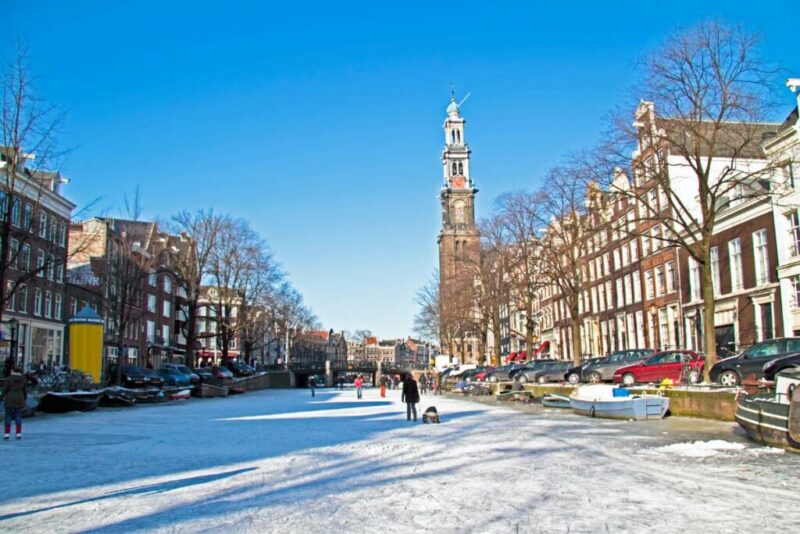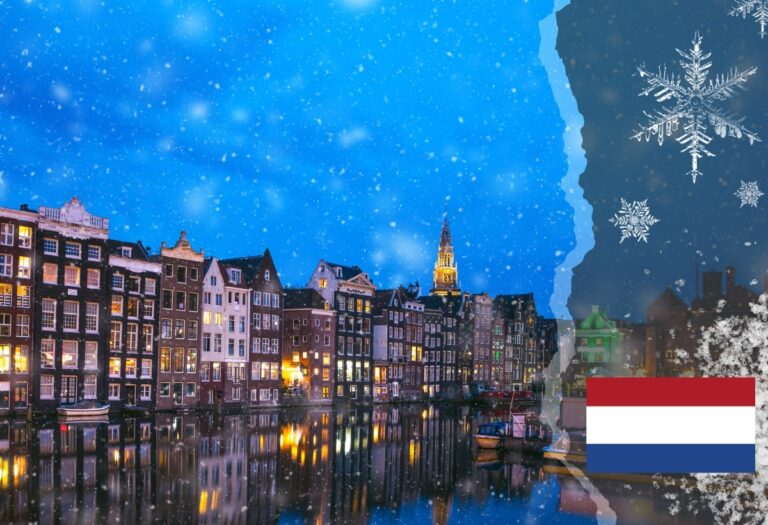Amsterdam, the capital city of the Netherlands, is renowned for its picturesque canals, charming architecture, and vibrant culture. But one question that often comes to mind is, “Does it snow in Amsterdam?” The city’s relatively mild climate and proximity to the coast may lead some to believe that snowfall is a rarity, but the truth is a bit more complex.
In this post, we will delve into the factors that influence snowfall in Amsterdam and explore the city’s history with the white stuff.
Does It Snow in Amsterdam?

Yes, it does snow in Amsterdam, although the city’s proximity to the coast and relatively mild climate means that snowfall is not as common as in other parts of the Netherlands or Europe.
On average, Amsterdam receives less than 3 inches of snow per year; the average number of days with snowfall in Amsterdam is around 10 days per year, with the heaviest snowfall typically occurring in January and February.
However, the amount of snowfall can vary greatly from year to year. Factors such as wind direction, temperature, and atmospheric pressure can all play a role in determining whether or not it will snow in Amsterdam.
How Often Does It Snow In Amsterdam?
The average number of days with snowfall in Amsterdam is around 10 days per year. However, this can vary greatly from year to year. Some years might have no snowfall at all, while others may see several inches of snow.
The heaviest snowfall typically occurs in January and February, but snowfall can happen any time from November to April.
The amount of snowfall also varies depending on the location in the Netherlands, Amsterdam’s location being relatively close to the coast and its mild climate makes it less likely to have heavy snowfall.
When Does it Snow In Amsterdam?

When it comes to snowfall in Amsterdam, the timing can be unpredictable. Snowfall in the city can happen as early as November and as late as April, but the heaviest snowfall typically occurs during the months of January and February.
However, it’s important to note that snowfall in Amsterdam is not guaranteed during these months and can also vary greatly from year to year.
The amount of snowfall also depends on various factors such as wind direction, temperature, and atmospheric pressure. Although Amsterdam’s mild climate and proximity to the coast makes it less likely to have heavy snowfall, it’s still possible to see snow in the city.
The Climate in Amsterdam
The climate in Amsterdam is classified as a maritime temperate climate, which is characterized by mild temperatures, moderate rainfall, and moderate humidity. The city is located in the west of the Netherlands, which is influenced by the North Sea, this makes it less exposed to the cold Arctic winds that affect the country’s eastern regions.
The average temperature in Amsterdam ranges from around 2°C (36°F) in January to around 19°C (66°F) in July. The city gets moderate rainfall throughout the year, with the wettest months being October and November.
Amsterdam also experiences relatively high humidity levels, especially in the summer months. The city also often experiences strong winds, mostly coming from the west, which can make the weather feel colder than it actually is.
Overall, Amsterdam’s climate is relatively mild and temperate, with temperatures that are milder than other parts of the Netherlands, and snowfall is less common, although it still happens.
The Seasons of Amsterdam
Amsterdam, like most of the Netherlands, experiences four distinct seasons throughout the year. Spring, which runs from March to May, is characterized by mild temperatures and increasing daylight hours.
The trees and flowers begin to bloom, and the city’s parks and gardens are filled with vibrant colors. During this season, Amsterdam’s famous tulip fields also start to bloom.
Summer, which runs from June to August, is usually the warmest season, with temperatures ranging from around 18-20°C (64-68°F). The days are long and sunny, and the city is bustling with tourists and locals alike.
Autumn, which runs from September to November, is a time when the leaves on the trees change color and fall, creating a picturesque scenery. The weather begins to cool down, and the days get shorter. Amsterdam’s famous canals and waterways are especially beautiful during this season.
Winter, which runs from December to February, is the coldest season, with temperatures ranging from around 0-5°C (32-41°F). The days are shorter and the weather is often cloudy and gray. This is the least popular time to visit the city, but Amsterdam can still be quite charming during this season, with its Christmas markets and cozy cafes.
It’s worth noting that Amsterdam’s mild climate and proximity to the coast means that these seasons may not be as extreme as in other parts of the country or Europe.
Things to Do in Amsterdam in Winter

There are plenty of things to do in Amsterdam during the winter season, despite the colder weather.
Some of the popular activities include:
- Visit a Christmas market: Amsterdam has several Christmas markets that take place in December, offering a festive atmosphere with twinkling lights, traditional food and drinks, and handmade gifts.
- Ice-skating: Amsterdam has several outdoor ice-skating rinks that open during the winter months. Some of the most popular rinks include the Museumplein rink and the Leidseplein rink.
- Take a canal cruise: Amsterdam’s canals are especially beautiful during the winter, and taking a canal cruise is a great way to see the city from a different perspective. Many companies offer heated boats for the colder months.
- Visit a museum: Amsterdam has many world-class museums, such as the Van Gogh Museum, the Rijksmuseum, and the Stedelijk Museum, which offer a great indoor activity on a cold winter day.
- Go shopping: Amsterdam has many shopping districts, such as the 9 Straatjes (9 streets) and the PC Hooftstraat, that offer a great selection of boutiques, department stores, and specialty shops.
- Indulge in some traditional Dutch cuisine: Amsterdam offers many cozy cafes and restaurants that serve traditional Dutch dishes, such as stroopwafels, poffertjes, and hot chocolate.
- Take a bike tour: Amsterdam is a bike-friendly city, and many companies offer guided bike tours, even in winter, so you can explore the city’s streets and canals in a different way.
- Visit a spa: Amsterdam has many spas and saunas where you can relax and unwind after a day of sightseeing.
Overall, Amsterdam in the winter offers plenty of opportunities to explore the city’s culture, history, and beauty, while enjoying cozy indoor and outdoor activities.
Conclusion: Does It Snow In Amsterdam?
In conclusion, Amsterdam does experience snowfall, although it is not as common as in other parts of the Netherlands or Europe.
The city’s mild climate and proximity to the coast mean that snowfall is not guaranteed, but it can happen any time from November to April, with the heaviest snowfall typically occurring in January and February.
However, the amount of snowfall can vary greatly from year to year and depends on various factors such as wind direction, temperature, and atmospheric pressure.
Related Articles
- Does It Snow In Germany?
- Does It Snow In Belgium?
- Does It Snow In Berlin?
- Does it Snow in Munich?
- Does It Snow In London?
- Does It Snow In England?
- Does It Snow In France?
FAQs: About Snow in Amsterdam
Is Snowfall in Amsterdam a Common Occurrence?
How Much Snow Does Amsterdam Typically Receive?
The heaviest snowfall typically occurs in January and February, but again it depends on various factors such as wind direction, temperature, and atmospheric pressure.
Are There Any Specific Winter Events or Festivals in Amsterdam That I Should Check Out?
It’s always recommended to check the city’s calendar of events to see what’s happening during your visit.
Related Posts:
- Does It Snow In Ketchikan, Alaska? Exploring the…
- Does It Snow In Tennessee? Discovering Its Winter Side
- Does It Snow In Malta? Is Winter an Actual Thing Here?
- Does It Snow In Joshua Tree National Park? Exploring…
- Does It Snow In Waco, Texas? From Texan Heat to…
- Does It Snow In Indiana? Is Winter Magic Real? Find Out Now!







